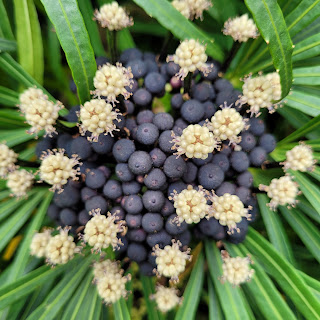Bird Encounters in The School and Neighbourhood
Written by: Mr William Teng
Updated on 5 July 2021 with correction identification of the Asian Glossy Starling.
Several bird species have been spotted in our school compound and along the Punggol WaterWay.
Asian Openbill
Scientific Name: Anastomus oscitans
Malay Name: Upih-Siput Asia
Chinese Name: 钳嘴鹳
Latin Etymology: Anastomus (Ancient Greek αναστομοω anastomoō meaning "to furnish with a mouth" or "with mouth wide-opened") oscitans (listless, sluggish, sleepy, which may refer to its gaping mouth which makes it look it is yawning)
This bird is large wading bird in the stork family Ciconiidae and forages in inland wetlands. It is only rarely seen along river banks and tidal flats.
A pair was spotted along the Punggol WaterWay when I was jogging in late March 2020. They had a greyish appearance and so I thought they were statues of birds placed for decorative purposes. Then, one of it turned its head and I realised that they were living birds. As I inched closer to the birds to take better photos of them, I startled them and they took flight.
Photo credit: Mr William Teng
Photo credit: Mr William Teng
References:
Sooty-headed Bulbul
Scientific Name: Pycnonotus aurigaster
Malay Name: Merbah Ubun Hitam
Chinese Name: 白喉红臀鹎
Latin Etymology: Pycnonotus (combination of Ancient Greek words puknos "thick" or "compact" and -nōtos "-backed") aurigaster (combination of aurum 'gold' and gaster 'belly')
This bird was spotted along the Punggol WaterWay in the late afternoon as I was walking home from school during the March holidays.
Photo credit: Mr William Teng
The body of this bird was found the courtyard of the school and was seen by many students. I was alerted to it by my Biology student, Garcia. The bird was previously suggested to be a juvenile Greater Racket-tailed Drongo but it is actually a juvenile Asian Glossy Starling.
Photo credit: Garcia (2020 4A)
Photo credit: Francis Yap (from Singapore Birds Project)
The bird was buried by Ms Kerry Lim and some of her Sec 1 students. Thank you.
References:
Long-Tailed Shrike
Scientific Name: Lanius schach
Malay Name: Tirjup Ekor Panjang
Chinese Name: 棕背伯劳
Latin Etymology: Lanius (derived from the Latin word for "butcher", and some shrikes are also known as "butcher birds" because of their feeding habits) schach (an onomatopoeic name based on the call)
The long-tailed shrike has been spotted in the school often. It is one of the few birds that visit the school compound often. You may have read about it in our blog post on Punggol Waterway (link). This familiar sight was photographed by Mr Nicholas Lim as he was exploring the school compound.
Photo credit: Mr Nicholas Lim
References:









Comments
Post a Comment